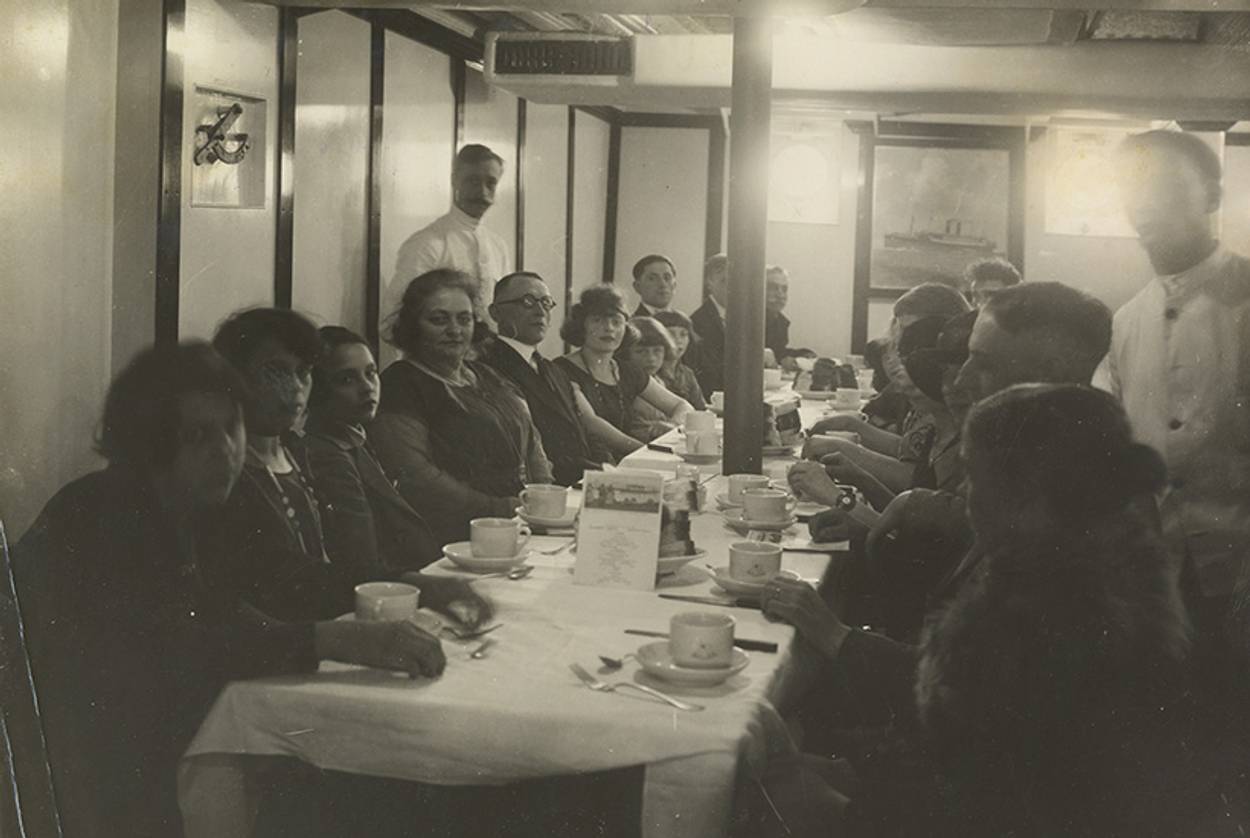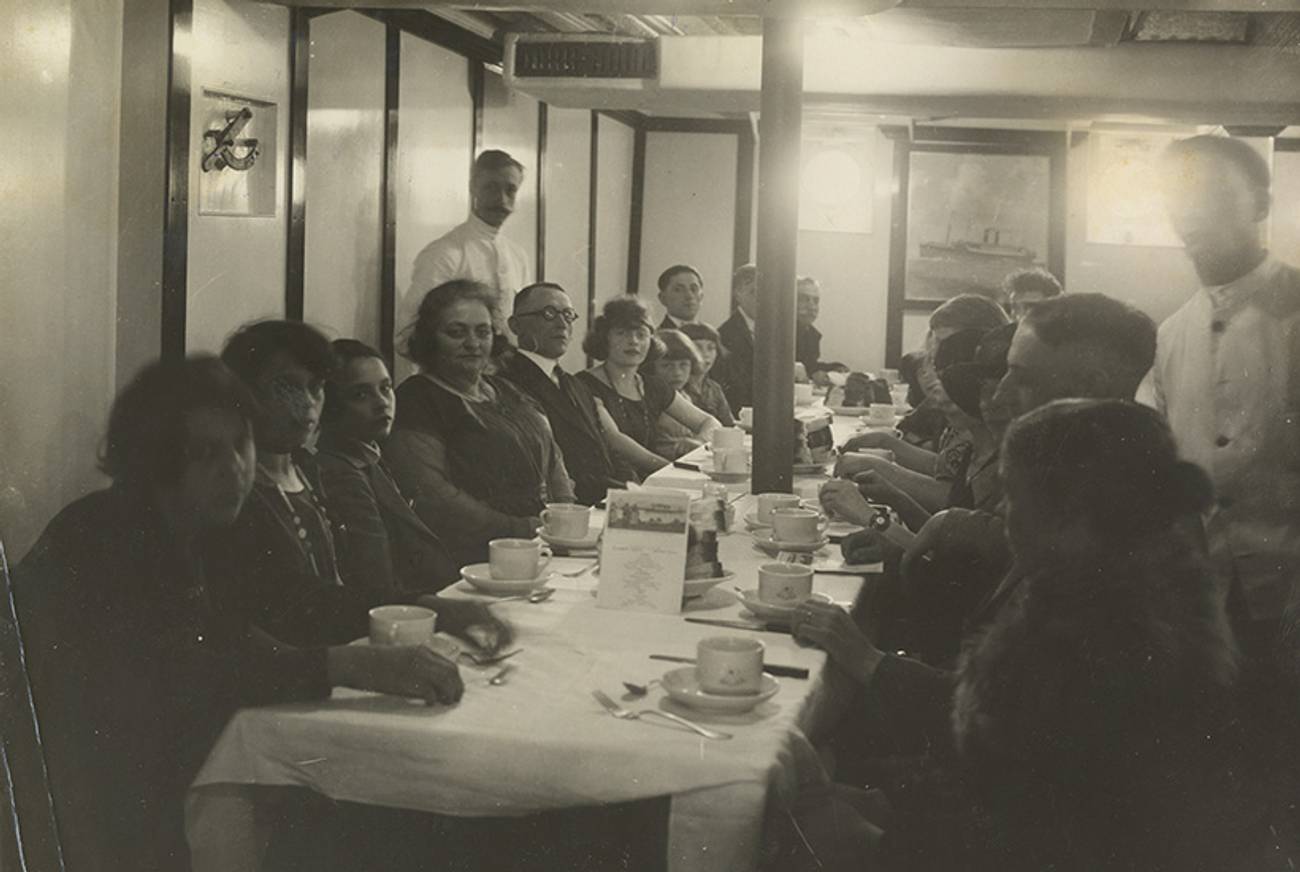Museum in Antwerp Recalls the Ships That Brought Einstein and Irving Berlin to America
The Red Star Line carried half a million Jewish refugees from Europe as they fled pogroms, anti-Semitism, and the Nazis




Sonia Pressman Fuentes was born in Berlin in 1928 to Polish Jewish parents. When Hitler rose to power in 1933, her brother Hermann fled to Antwerp, where she and her parents reunited with him a few months later. Unfortunately, no one in her family was legally allowed to stay in Belgium. The Belgian national security bureau prepared to deport them back to Poland, where her parents had been born—though they hadn’t lived there in about 20 years.
“Had we been deported,” Fuentes said, “we would truly have gone to our deaths.”
Luckily, the family gained visas to go the United States, and on April 20, 1934, they boarded the Red Star Line’s Westernland and arrived at Ellis Island on May 1. If not for securing those visas and taking that fateful voyage, Fuentes would not have gone on to become a women’s rights leader, co-founding the National Organization for Women and working as an attorney for the Equal Employment Opportunity Commission.
Fuentes is just one of the influential Jewish émigrés for whom Antwerp was a gateway to the New World. Thanks to the new Red Star Line Museum, which opened this fall in Antwerp, the story of how the company’s steamships ushered Eastern European Jews to the United States, and how those immigrants changed the face of the nation, can finally be told.
The Red Star Line’s other iconic Jewish passengers include Albert Einstein, who fled Nazi Germany aboard the Westernland in 1933; he wrote his resignation letter to the Prussian Academy of Sciences on Red Star Line letterhead. And the Red Star Line didn’t carry just those who were fleeing Hitler; it had already been bringing Jews to America for about 60 years. In 1893, for instance, 5-year-old Israel Isidore Baline and his family left Russia for the United States via Antwerp on the SS Rhynland. He changed his name to Irving Berlin, and in his newly adopted country, he later penned some of the most iconic American songs of all time, including “God Bless America.” As Antwerp’s Vice Mayor Philip Heylen said at a preview event for the museum in September, “There would be no ‘White Christmas’ without Red Star.”
The Red Star Line served as an escape hatch for over half a million Jews seeking sanctuary from 1873 to 1934. The narrative of Jewish immigration from Europe to the United States often overlooks the importance of these ships. “None of the migration would have happened without the development of lines like Red Star,” said Hasia Diner, professor of Jewish history at New York University, via email.
“I am of course grateful and fortunate beyond words to have been one of the millions of passengers who traveled to the United States and Canada on Red Star Line ships,” said Fuentes in a speech at the new museum in September, standing on the same ground where she set sail for the United States 80 years ago. “My family’s voyage saved our lives.”
***
Thirteen years ago, the Red Star Line’s historic buildings stood empty and in peril and were slated to be sold off. But in 2001, they were saved when, following much lobbying, the Belgian government deemed the structures protected monuments. The same architects who restored the structures at Ellis Island—Beyer Blinder Belle—were hired to rejuvenate the buildings.
Historian Bram Beelaert was brought on to curate a new museum in the space where passengers once gathered. Beelaert and his team needed to imbue the museum’s walls with personal stories to illustrate the ocean liners’ history and portray the immigrants’ journeys. “How do you evoke the hope, expectations, fear, disappointments in a credible way?” Beelart asked.
Unfortunately, the transoceanic line shut down in 1934; many of its adult passengers are no longer alive. Any remaining passengers traveled as children, like Fuentes, and often didn’t recall their time aboard the ships. So, the Red Star Line Museum partnered with the Ellis Island Museum and the YIVO Institute for Jewish Research. “We got life stories and oral histories of immigrants who took the boat in Antwerp from their collections,” Beelaert told me via email. His team also enlisted a genealogist to track down descendants of passengers: “[We] gained access to their families’ archives and did research … in Krakow, Warsaw, and Moscow.”
Thanks to a 2009 article in the Forward about the creation of the new museum, Fuentes reached out to the curators, thinking, “What have I got to lose?” Beelaert said that the museum had extensive contact with Fuentes since then: “[We] went together with her to the archives here in Belgium” to research her lost personal history. Fuentes said, “Much of the information they gave me I had never known before,” including her family’s close call with deportation and Fuentes’ brief time living in the Orthodox district of Antwerp before leaving for the United States.
In addition to showcasing personal stories like Fuentes’, the museum also features its prized pieces: Irving Berlin’s piano, Einstein’s handwritten letter of resignation, and artwork by artist Eugeen Van Mieghem depicting Red Star Line voyagers. The exhibit recreates the experience of leaving one’s motherland for the New World, from the travel agency to the city of Antwerp to the steamship to the Ellis Island processing center. Photos and personal artifacts abound, all within the historic walls where the original journeys took place.
Though the museum focuses on more than Jewish migration, the Jewish stories make up a significant part of the material. As Irving Berlin’s granddaughter Caroline Emmet-Bourgois said while visiting the museum in September, “We tend to forget how hard it is to emigrate. You are leaving behind your identity. … You are trying to give a future to your children, and you are willing to lose what you already have to start anew.”
***
The first big wave of Jewish immigration from Europe to the United States began right before the pogroms of the late 19th century. “Jews from particularly Lithuania had been immigrating from the 1860s onward,” Diner said. Then in 1882, as violent anti-Semitism became widespread across Eastern Europe, more and more Jews fled persecution. “It was the first awakening,” YIVO CEO Jonathan Brent told me, “to the fact that the Jews no longer had a real home in Eastern Europe.”
“The turn of the century produced all the upheaval that led to, and was devastating in, the aftermath of WWI,” Brent noted. “This simply provided confirmation to what people thought in 1882: that Jews have got to get out.”
“America functioned as a magnet for Jews leaving Europe” during this period, Diner wrote in The Jews of the United States. Via email, she added: “The United States was the most dynamic economy in the world. It offered tremendous opportunity for white people who could take advantage of expanding economic developments.”
“Antwerp was not the leading port for Eastern European Jews,” said Barry Moreno, Ellis Island Museum historian, via email. Almost half of Eastern European immigrants traveled through Hamburg and Bremen, followed by Libau, with Antwerp as the fourth-most-popular port. Jewish migration through Antwerp is estimated at about 625,000 people in total, or one in four of the 2.5 million total immigrants on the Red Star Line. But Erwin Joos, curator at Antwerp’s Eugeen Van Mieghem Museum, told me that he believes the number was higher: Immigration centers didn’t keep track of religious affiliations, and letters from Jewish sojourners in Antwerp suggest that boarding houses were brimming with Jewish immigrants. As for the annual numbers, Moreno said that each year there were between 3,500 and 7,500 Jewish immigrants—until 1902, when the number climbed to over 15,000.
One benefit of setting sail for the United States aboard the Red Star Line was its low cost. Joos said that, because Antwerp’s line competed directly with Hamburg’s, the Red Star Line kept its prices modest. Diner said that family members already in the United States often purchased tickets for those back home to join them, so they were looking for the “cheapest, easiest to get to, least cumbersome port available” for their relatives back home. Joos noted that “Antwerp was very popular for steerage, for third class.” Through the 1890s, steerage meant traveling in “poorly lit, noisy, overcrowded” areas, according to the museum, though conditions improved in the ensuing years.
One big challenge in Antwerp was the lack of support for the travelers. Moreno said that, unlike the German ports, which offered lodging to emigrants, Belgian ports provided nothing. Jews and other emigrants stayed in sometimes expensive boarding houses; they were at the mercy of swindlers with scant protection from local authorities. Moreover, the lodgings themselves were often filthy and overcrowded.
Though in Fuentes’ case she was too young to remember her time in Antwerp, those who traveled as adults were often quick to bury this part of their histories. Joos said of the descendants of Red Star Line passengers: “Sometimes it’s the parents [who] didn’t want to talk about it to their children. They were traveling in such dire conditions that they were ashamed to tell them [about it].”
YIVO presented a panel discussion on the Red Star Line four years ago. “I think it came as a real surprise to people that Antwerp was a major immigration site for Jews,” said Brent, “and that the Red Star Line played such an important role in the Jewish world.”
Beelaert will give several talks in the United States in December, exploring the link between Antwerp’s transatlantic carrier and the history of Jewish migration. He will appear in New York City at the 92nd St. Y on Dec. 2, in Philadelphia at the National Museum of American Jewish History on Dec. 3, and in Detroit at the Adat Shalom Synagogue on Dec. 8. He said that after this “big, complicated, and sometimes difficult project, the dialogue with the audience is very exciting.”
***
Like this article? Sign up for our Daily Digest to get Tablet Magazine’s new content in your inbox each morning.
Grace Bello is a freelance writer and writing teacher based in New York.
Grace Bello is a freelance writer and writing teacher based in New York.